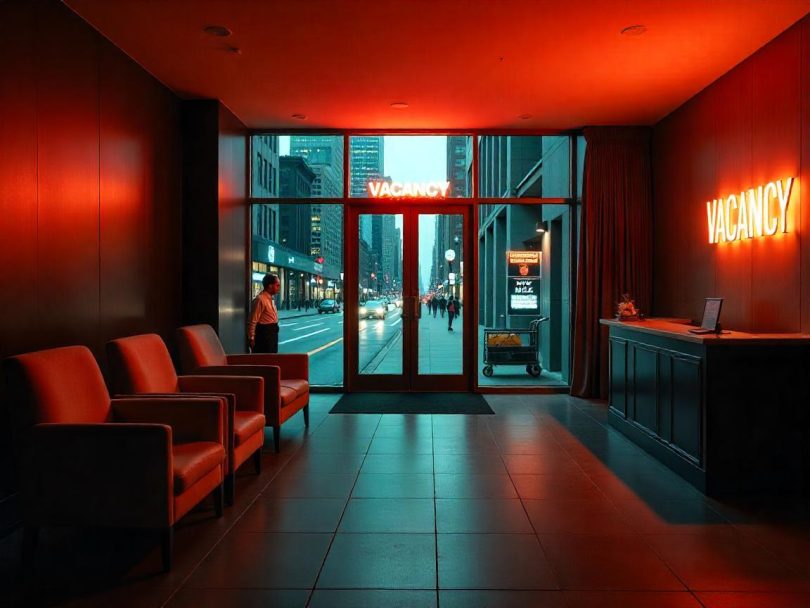Tuesday, June 3, 2025
New York City hotels are being hit hard, and the storm isn’t letting up. The Trump-era tourism slump continues to deepen, sending shockwaves across the city’s hospitality scene. Now, industry leaders and workers are stepping forward with urgency. They’re demanding tax relief—not tomorrow, but now—to save jobs and revive New York’s travel economy before it’s too late. The decline isn’t subtle. Hotel lobbies are quiet. Room bookings are flat. Jobs are disappearing. And the pressure is mounting fast. As the slump stretches on, what once felt like a temporary downturn now feels dangerously permanent. Meanwhile, leaders warn that without action, more hotels will shutter, and workers will suffer. New York City’s travel economy, once a powerhouse, is teetering. The question now is: will relief arrive in time? Or will the Trump-era tourism damage become an irreversible blow to the city’s global identity? The stakes have never been higher—and the clock is ticking.
New York City, long considered the heartbeat of global tourism, is facing a deepening crisis. Hotel lobbies that once bustled with international visitors now echo with uncertainty. Bookings are down. Revenues are falling. And the culprit, many insiders believe, is a lingering Trump-era tourism slump that continues to chill the city’s global appeal.
As international arrivals lag and domestic travel shifts elsewhere, NYC’s hotel sector is facing an urgent reckoning. Owners and hospitality workers are sounding the alarm, pressing city officials for swift tax relief before more closures and layoffs darken the skyline.
The Lingering Impact of the “Trump Slump”
The so-called “Trump slump”—a phrase used to describe the sharp decline in international tourism during and after Donald Trump’s presidency—continues to haunt New York’s travel economy. While political shifts have faded from headlines, the effects remain visible in hotel occupancy charts and revenue forecasts.
The city, which once welcomed nearly 13.5 million international visitors annually, has seen that number shrink dramatically. And it’s not bouncing back at the rate seen in other U.S. cities. Major tourism markets like Los Angeles, Miami, and Chicago have rebounded faster. But New York continues to feel the sting of lost global goodwill.
Hotels on the Brink: Empty Rooms, Rising Costs
New York’s hotel sector, already burdened by pandemic losses, is struggling to fill rooms. Many properties in Midtown, SoHo, and Lower Manhattan report occupancy rates hovering below 60%—a figure well below pre-pandemic norms. Luxury hotels have cut back staff. Budget properties are slashing rates just to compete. And some buildings sit shuttered altogether.
The cost of staying open in New York is high. Property taxes, energy bills, and wages have all climbed, even as guest revenue remains stagnant. For hotel owners, the math no longer adds up. Without relief, they warn that a wave of closures could sweep through the city—impacting not just tourism, but thousands of livelihoods tied to the sector.
Workers Left in Limbo
Behind every hotel desk, housekeeping cart, and concierge counter is a worker who depends on steady tourism to survive. And as bookings dip, hours are cut. Tips vanish. Stability disappears.
Unions and labor groups representing hotel workers are now rallying alongside property owners. Together, they’re urging city and state leaders to approve targeted tax relief measures that could offset operational losses and help properties stay afloat. The message is unified: saving hotels means saving jobs.
Moreover, the fear isn’t just about the present—it’s about what the future holds. If hotels close, even temporarily, the ripple effects will hit restaurants, tour operators, cab drivers, and countless small businesses that thrive on visitor spending.
Global Travelers Choosing Elsewhere
While New York remains a dream destination for many, global tourists are now weighing other options. Safety concerns, visa delays, and political perceptions continue to shape choices. Many travelers from Europe, Asia, and Latin America are skipping the U.S. altogether—or redirecting their dollars to destinations perceived as more welcoming.
Travelers once eager to photograph the Manhattan skyline or walk Central Park are now opting for Canada, Japan, or Dubai. The loss isn’t just symbolic—it’s economic. Each skipped visit means fewer bookings, lower retail sales, and reduced city tax revenues.
The Call for Tax Relief: A Lifeline or Too Late?
Industry leaders believe tax relief could be the turning point. By temporarily easing property tax burdens or offering targeted credits, the city could help hotels stay operational during this volatile period.
Such relief wouldn’t just support big brands. It would help independent hotels, family-run lodges, and culturally iconic properties that give New York its soul. It’s about preserving the identity of a city built on diversity and hospitality.
Moreover, advocates argue that investing in the tourism industry now will pay long-term dividends. With marketing efforts, upgraded infrastructure, and a strong service workforce, New York could regain its global standing faster—attracting the very visitors it’s now losing.
The Road Ahead: Urgency, Unity, and Uncertainty
Time is not on the city’s side. Every month without action pushes more properties closer to insolvency. Workers face ongoing instability. And the reputation of NYC as a world-class destination remains at risk.
However, there’s hope. The city has rebounded from crises before—financial collapse, terror attacks, hurricanes, and pandemics. The travel sector has always been a cornerstone of its resilience. But this time, it needs help.
Tourism officials are pushing hard. Business leaders are showing rare unity with labor. The mood is urgent. The stakes are real. And the future of New York’s travel economy may depend on decisions made in the coming weeks.
Because while the Trump-era slump began years ago, its effects are still unfolding—and only bold, coordinated action can stop it from becoming permanent.











